Scottish Health Survey - topic report: equality groups
Topic report in the Scottish Health Survey series providing breakdowns of key health behaviours and outcomes by gender, age, ethnic group, religion, disability and sexual orientation.
9 Cardiovascular disease and diabetes
Summary
- Men were slightly more likely than women to have a CVD condition or diabetes.
- Prevalence of CVD and diabetes increased with age.
- Chinese people had the lowest prevalence of CVD whilst diabetes prevalence was highest among Pakistani and Indian ethnic groups.
- Muslims, Hindus and those who belonged to no religious group were less likely to have CVD whilst Roman Catholics had higher prevalence.
- Muslims had the highest prevalence of diabetes of all religious groups.
- Disabled respondents were more likely to have CVD or diabetes than those without a disability although the prevalence of diabetes was the same for those with limiting and non-limiting conditions.
- Respondents who identified themselves as lesbian or gay were significantly less likely to have diabetes than the national average.
9.1 Measures of cardiovascular disease and diabetes
Participants were asked whether they had suffered from any of the following conditions: angina, heart attack, stroke, heart murmur, irregular heart rhythm, or 'other heart trouble'. Respondents were also asked whether they had ever been told that they had one of these conditions by a doctor. For the purposes of this analysis, respondents were classified as having a CVD condition only if they reported that the diagnosis was confirmed by a doctor.
Participants were asked whether they suffered from diabetes and, if so, whether they had ever been told they had the condition by a doctor. Only those who reported that the diagnosis was confirmed by a doctor were classified as having diabetes. Women whose diabetes occurred only during pregnancy were excluded from the classification. No distinction was made between type 1 and type 2 diabetes in the interview.
9.2 CVD and diabetes by gender
There was a small but significant difference in the prevalence of CVD between men and women with men being more likely to have a CVD condition (16% vs 14%) . There were also significantly more men (6%) than women (4%) with doctor-diagnosed diabetes.
9.3 CVD and diabetes by age
There was a strong association between CVD and age. The likelihood of having a cardiovascular condition increased steadily with age from 5% of 16-24 year olds, to 41% of over 75 year olds.
Figure 9A: Prevalence of cardiovascular disease (CVD), by age, 2008-2011 combined
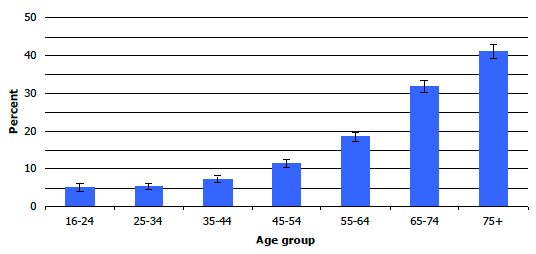
The prevalence of diabetes also increased with age. This was more pronounced between the ages of 45-54 and the 65-74 age group, where diabetes prevalence rose from 5% to 12%.
Figure 9B: Prevalence of diabetes, by age, 2008-2011 combined
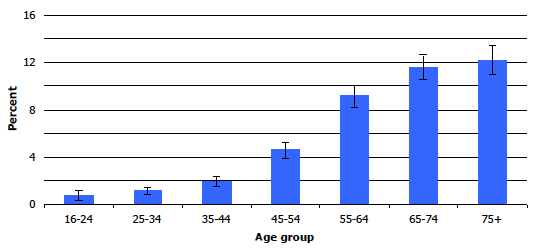
9.4 CVD and diabetes by ethnic group
Chinese respondents were the least likely to have a doctor-diagnosed CVD condition (4%), significantly lower than the national average (15%). No Asian Other respondents reported a CVD condition, although this may be due to the relatively small number of people surveyed in this category (103 over the four years).
South Asians have been found to have an increased risk of coronary heart disease compared to European ethnic groups.1 The Scottish Health Survey data doesn't support this as the prevalence of CVD among Indian and Pakistani respondents was not significantly different from the average. This may be partly due to small sample sizes being unable to identify significant differences.
African and Caribbean ethnic groups were found to have lower risks of heart disease compared to European groups.1 The Scottish Health Survey data shows that African, Caribbean or Black respondents had a lower than average prevalence of CVD (8%), although this wasn't statistically significant.
Figure 9C: Prevalence of cardiovascular disease (CVD), by ethnic group, 2008-2011 combined
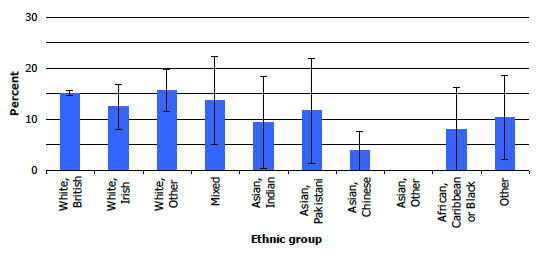
Pakistani (18%) and Indian (14%) respondents had the highest prevalence of diabetes although only the Pakistani figure was significantly higher than the average. The high prevalence of diabetes among south Asians living in the UK was also noted in a report by Diabetes UK.2 Chinese, Asian Other, Mixed and African, Caribbean or Black ethnic groups all had low levels of diabetes (ranging from 3% to 4%) although none of these were significantly different from the national average.
Figure 9D: Prevalence of diabetes, by ethnic group, 2008-2011 combined
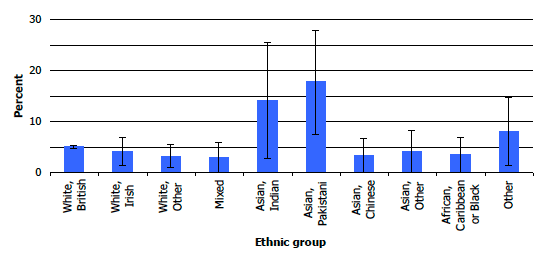
9.5 CVD and diabetes by religion
Muslims (9%), Hindus (3%) and those who said they belonged to no religion (14%) had significantly lower prevalence of CVD than the national average (15%) whilst Roman Catholics (17%) were significantly more likely to have a CVD condition.
Figure 9E: Prevalence of cardiovascular disease (CVD), by religion, 2008-2011 combined
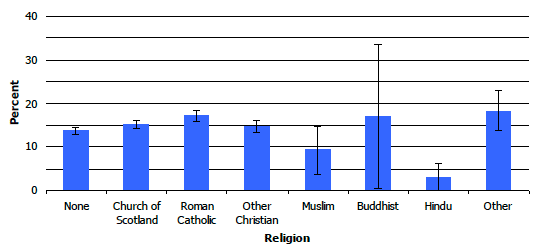
Muslims respondents had a much higher prevalence of diabetes (18%) than the national average. Diabetes prevalence among those who reported 'Other' religion was also significantly higher than average (8%). Prevalence among those who reported belonging to no religious group was very slightly, but significantly, lower than average.
9.6 CVD and diabetes by disability
As would be expected, there was a significant association between cardiovascular disease and disability. 24% of individuals with a limiting long-term condition had CVD, compared with 14% with a non-limiting condition and 9% with no condition.
Respondents with any kind of long-term condition were significantly more likely to be diabetic, although there was no difference in diabetes prevalence between those with a limiting and non-limiting condition (both 9%).
9.7 CVD and diabetes by sexual orientation
There was no association between sexual orientation and prevalence of CVD conditions. Respondents who self-identified as gay or lesbian had a significantly lower prevalence of diabetes (2%) than the national average (5%).
Figure 9F: Prevalence of diabetes, by sexual orientation, 2008-2011 combined
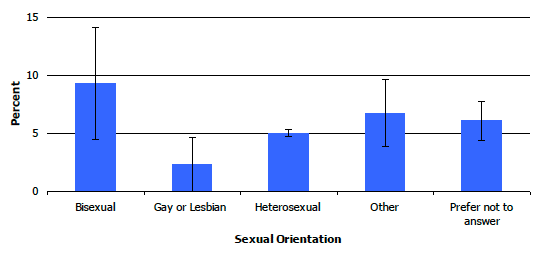
Contact
Email: Julie Ramsay
There is a problem
Thanks for your feedback